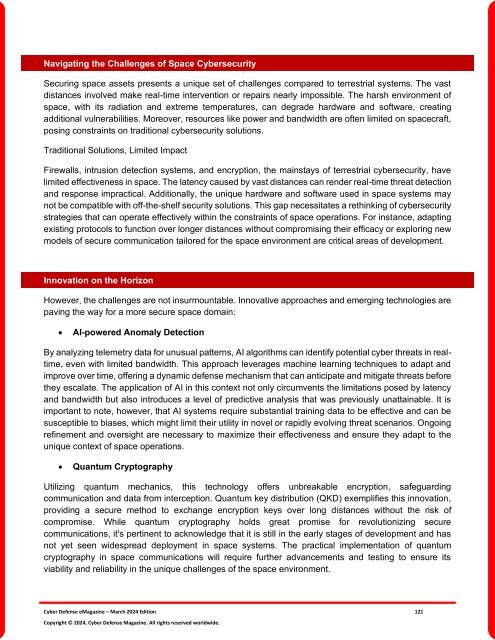The Cyber Defense eMagazine March Edition for 2024
Cyber Defense eMagazine March Edition for 2024 #CDM #CYBERDEFENSEMAG @CyberDefenseMag by @Miliefsky a world-renowned cyber security expert and the Publisher of Cyber Defense Magazine as part of the Cyber Defense Media Group as well as Yan Ross, Editor-in-Chief and many more writers, partners and supporters who make this an awesome publication! 225 page March Edition fully packed with some of our best content. Thank you all and to our readers! OSINT ROCKS! #CDM #CDMG #OSINT #CYBERSECURITY #INFOSEC #BEST #PRACTICES #TIPS #TECHNIQUES
Cyber Defense eMagazine March Edition for 2024 #CDM #CYBERDEFENSEMAG @CyberDefenseMag by @Miliefsky a world-renowned cyber security expert and the Publisher of Cyber Defense Magazine as part of the Cyber Defense Media Group as well as Yan Ross, Editor-in-Chief and many more writers, partners and supporters who make this an awesome publication! 225 page March Edition fully packed with some of our best content. Thank you all and to our readers! OSINT ROCKS! #CDM #CDMG #OSINT #CYBERSECURITY #INFOSEC #BEST #PRACTICES #TIPS #TECHNIQUES
Create successful ePaper yourself
Turn your PDF publications into a flip-book with our unique Google optimized e-Paper software.
Navigating the Challenges of Space <strong>Cyber</strong>security<br />
Securing space assets presents a unique set of challenges compared to terrestrial systems. <strong>The</strong> vast<br />
distances involved make real-time intervention or repairs nearly impossible. <strong>The</strong> harsh environment of<br />
space, with its radiation and extreme temperatures, can degrade hardware and software, creating<br />
additional vulnerabilities. Moreover, resources like power and bandwidth are often limited on spacecraft,<br />
posing constraints on traditional cybersecurity solutions.<br />
Traditional Solutions, Limited Impact<br />
Firewalls, intrusion detection systems, and encryption, the mainstays of terrestrial cybersecurity, have<br />
limited effectiveness in space. <strong>The</strong> latency caused by vast distances can render real-time threat detection<br />
and response impractical. Additionally, the unique hardware and software used in space systems may<br />
not be compatible with off-the-shelf security solutions. This gap necessitates a rethinking of cybersecurity<br />
strategies that can operate effectively within the constraints of space operations. For instance, adapting<br />
existing protocols to function over longer distances without compromising their efficacy or exploring new<br />
models of secure communication tailored <strong>for</strong> the space environment are critical areas of development.<br />
Innovation on the Horizon<br />
However, the challenges are not insurmountable. Innovative approaches and emerging technologies are<br />
paving the way <strong>for</strong> a more secure space domain:<br />
• AI-powered Anomaly Detection<br />
By analyzing telemetry data <strong>for</strong> unusual patterns, AI algorithms can identify potential cyber threats in realtime,<br />
even with limited bandwidth. This approach leverages machine learning techniques to adapt and<br />
improve over time, offering a dynamic defense mechanism that can anticipate and mitigate threats be<strong>for</strong>e<br />
they escalate. <strong>The</strong> application of AI in this context not only circumvents the limitations posed by latency<br />
and bandwidth but also introduces a level of predictive analysis that was previously unattainable. It is<br />
important to note, however, that AI systems require substantial training data to be effective and can be<br />
susceptible to biases, which might limit their utility in novel or rapidly evolving threat scenarios. Ongoing<br />
refinement and oversight are necessary to maximize their effectiveness and ensure they adapt to the<br />
unique context of space operations.<br />
• Quantum Cryptography<br />
Utilizing quantum mechanics, this technology offers unbreakable encryption, safeguarding<br />
communication and data from interception. Quantum key distribution (QKD) exemplifies this innovation,<br />
providing a secure method to exchange encryption keys over long distances without the risk of<br />
compromise. While quantum cryptography holds great promise <strong>for</strong> revolutionizing secure<br />
communications, it's pertinent to acknowledge that it is still in the early stages of development and has<br />
not yet seen widespread deployment in space systems. <strong>The</strong> practical implementation of quantum<br />
cryptography in space communications will require further advancements and testing to ensure its<br />
viability and reliability in the unique challenges of the space environment.<br />
<strong>Cyber</strong> <strong>Defense</strong> <strong>eMagazine</strong> – <strong>March</strong> <strong>2024</strong> <strong>Edition</strong> 121<br />
Copyright © <strong>2024</strong>, <strong>Cyber</strong> <strong>Defense</strong> Magazine. All rights reserved worldwide.

















